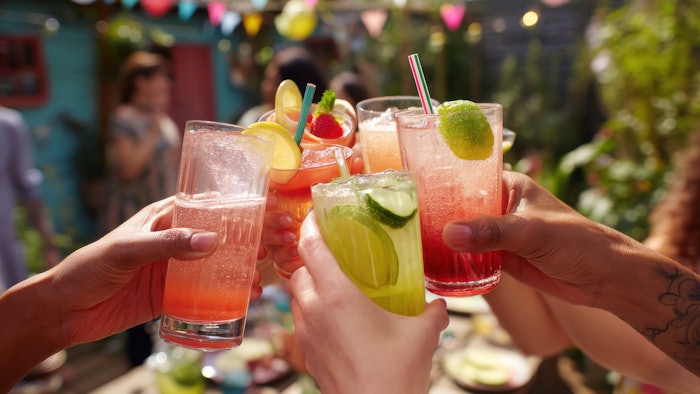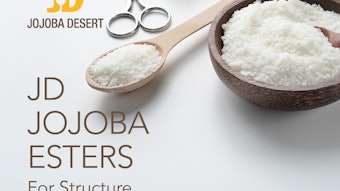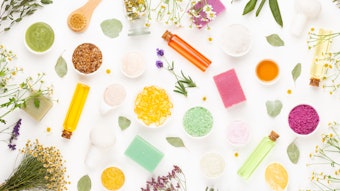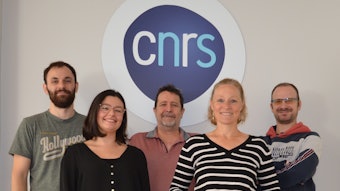
Studies show that drinking in moderation is becoming more popular in every age group, with 21% of consumers drinking less alcohol than they did last year and 22% switching between alcohol and nonalcohol options during the same occasion.
Alcohol is no longer an all-or-nothing proposition. Today’s culture treats drinking cocktails and mocktails and everything in between as an experience that brings Elizabeth Kreger, PhD, innovation and analytical manager, research and development, Sensient Flavors & ExtractsCourtesy of Sensient
Elizabeth Kreger, PhD, innovation and analytical manager, research and development, Sensient Flavors & ExtractsCourtesy of Sensient
Consumers increasingly want to choose what suits them in the moment without sacrificing fun or flavor. Therefore, low- and no-alcohol options need to capture the spirit of why people drink to begin with and incorporate all aspects to replicate the carefully mixed ingredients and sensory experiences of a traditional cocktail.
Specifically, the ready-to-drink (RTD) category is evolving to incorporate cocktail and mocktail options that recognize and emphasize the experience and purpose behind a consumer’s beverage choice, leveraging flavor, color, aroma and mouthfeel to create the intended emotional effect.
The key is to create a multi-sensorial experience that gives low- and no-alcohol Adam Kitchen, applications technical service manager, Sensient Flavors & ExtractsCourtesy of Sensient
Adam Kitchen, applications technical service manager, Sensient Flavors & ExtractsCourtesy of Sensient
What Matters Most to Consumers
The level of alcohol is only one aspect of the purchasing decision when choosing a beverage that matches the moment, but it is becoming a more important element with consumers’ changing drinking preferences.
Sobriety used to be reserved for very specific situations, but alcohol alternatives are growing in popularity with a broader audience as part of the sober curious movement for a variety of reasons, including:
- Health concerns
- Calorie consumption
- Mood or behavior implications
- Changing social norms and attitudes
- Responsible driving
- Wellness goals
- Availability of alternatives, such as adaptogens, mushroom extracts, lion’s mane and THC products where laws permit
Regardless of the reason for reexamining their relationship with alcohol, there are three clear motivators for what plays into consumers’ decisions about beverages:
- Flavor
- Experience
- Engaging all senses
Flavor is still the number one inspiration for people when choosing products. More than half of consumers say that a unique flavor is the top influencer in their purchasing decision.
Consumers also look to enhance or create a particular mood, and they opt for specific characteristics depending on whether they want to relax, celebrate, explore or simply socialize.
Finally, today’s consumers seek out more complexity across all categories, and they demand an experience that engages them more fully in their foods and beverages. Nonalcoholic ready-to-drink options used to be limited to flavored water or sparkling juice. Now, beverage developers need to expand their approach from merely balancing the sugar and acid to balancing the entire flavor profile with multi-sensorial formulations that may include florals and botanicals, bitters, specific alcohol types and flavors, and alcohol sensations like mouth burn or prickle. More modern mocktail menus have matured to include upscale and exotic flavors, interesting pairings with food items, craft brews and functional aspects.
 More than one-fourth of RTD drinkers strongly prefer the ready-to-drink format over traditional cocktailsboykovi1991 at Adobe Stock
More than one-fourth of RTD drinkers strongly prefer the ready-to-drink format over traditional cocktailsboykovi1991 at Adobe Stock
Ready-to-Drink Is Ready for the Challenge
Ready-to-drink cocktails and mocktails paired with formulation complexity are positioned well for the rise in alcohol-conscious consumption.
The category encompasses a wide range of products, including flavored malt beverages, malt-based hard seltzers, spirit-based hard seltzers, pre-made cocktails and wine-based seltzers or spritzers. Each of these subcategories provides varying degrees of alcohol and alcohol-free formulations.
Many RTDs already have a lower alcohol by volume (ABV) than other alcohol types. And consumers want to choose from a full spectrum of ABV to match a moment when selecting a beverage: no alcohol, low ABV and traditional options.
Interestingly, more than one-fourth of RTD drinkers strongly prefer the ready-to-drink format over traditional cocktails. There are many benefits that speak to consumer expectations. RTDs are:
- Convenient. It is much simpler to have RTD options available than to stock spirits and mixers for a variety of drinks.
- Portable. RTDs are easy to grab and go, making BYOB events and tailgating parties a breeze.
- Consistent. Many drinkers are not experienced or capable mixologists, so RTDs offer consistency in cocktail or mocktail quality and flavor.
- Adventurous. Variety packs and unique flavors let consumers explore their taste preferences while meeting the needs of all their guests. This trend spurred the concept of beverage flights based on a theme.
- Time-saving. RTDs are ready whenever you are. There is no need to spend 20 minutes assembling ingredients and carefully concocting specialty drinks while everyone else is enjoying the social interaction.
- Predictable and Reliable. It is easier to monitor and control alcohol consumption when the ABV is clearly stated on the bottle or can.
- Delicious. RTDs are carefully formulated and taste tested to match popular cocktail flavors and respond to social trends. Even low- and no-alcohol options appeal to multiple senses and mimic that “real” cocktail experience.
Making a Mocktail "Feel Real"
According to Mintel, one-quarter of consumers who drink alcohol alternatives look for substitutes that make them feel like they are still drinking alcohol.
Beverage scientists have identified a range of characteristics that help a mocktail feel more like the real thing, including alcohol-type flavors, similar mouthfeel, a Non-alcoholic beers and mocktails are top sellers because they provide unique formulas and flavors that deliver a craft experience similar to their traditional counterparts.Stanislav Loginov at Adobe Stock
Non-alcoholic beers and mocktails are top sellers because they provide unique formulas and flavors that deliver a craft experience similar to their traditional counterparts.Stanislav Loginov at Adobe Stock
NA beers and mocktails are top sellers because they provide unique formulas and flavors that deliver a craft experience similar to their traditional counterparts.
One of the biggest challenges in mimicking the feel of a cocktail is recreating the characterizing flavors of common liquors. The solution often requires the expertise of a master flavorist who specializes in replicating the nuanced flavor profiles of popular liquors like tequila, gin, white rum, whiskey and others.
Another challenge for developers is achieving the typical mouthfeel of popular cocktails. Ethanol, for example, creates a mouthfeel that includes burn, body and weight. Other components to consider include a sweet or syrupy feel, temperature sensations like cooling mint, astringency to imitate the mouth-drying sensation from the barrel or cask in an aged spirit, foaming activity or cloudiness.
In addition, flavor is influenced by our eyes and noses almost as much as our taste buds. In fact, the nose boasts 400 odor receptors that can detect more than 10,000 compounds! Our sense of smell is responsible for assigning the characterizing flavors we associate with different spirits. There is a fascinating study about whether to add water to whiskey that goes into great detail about how water affects the way aroma gets released to hit the optimal ABV and flavor balance. Scientists have even studied people’s sensory preferences based on the size of the bubble in carbonation. (Spoiler alert: People like tiny bubbles better.)
Flavor, color, mouthfeel, texture, temperature and aroma can all affect the consumer experience. And all of those aspects can be more consistent when using RTD products than when hand-mixing beverages, regardless of alcohol content.
An experienced flavor expert can work closely with developers to identify end goals and consider solutions that address these complicated challenges. A toolbox of flavor technologies can help beverage makers achieve the taste, mouthfeel and sensory complexity needed to successfully compete on shelves.
Standing Out in a Competitive Category
The ready-to-drink category is a well-established market with a lot of competition for shelf space. Varying the degree of ABV or offering zero-proof options creates a value-added differentiator that taps into the growing trend of mindful drinking.
From a development perspective, pairing this alcohol alternative approach with other trends will help products stand out. For example:
- Mimic common alcohol flavors like tequila, gin, rum and whiskey regardless of ABV level.
- Focus on flavor. Unique flavors drive more than half of purchasing decisions in the RTD space. Consider pairing a tropical or exotic fruit with a more familiar flavor profile to stretch palates and entice adventure.
- Go upscale. Consumers often seek out something special to celebrate personal achievements or commemorate milestones. Botanicals and florals boost the perception of glamor and luxury.
- Borrow from crossover categories. Tap into the success of popular flavor profiles in adjacent categories.
- Consider a limited time offer. Test a unique concept by creating urgency and exclusivity. It can sometimes lead to a full-time SKU.
- Engage as many senses as possible. Each new sensory experience creates another connection and another trigger for purchasing again.
A Bevy of Beverage Options
The RTD market is not only growing, it is becoming more varied and complex, providing a bevy of benefits that instill brand loyalty. People are searching for variety and alternative options for occasions that used to only serve alcohol, with consumers wanting a beverage “experience” that does not depend on alcohol content.
Developers and consumers should be open to new ideas and lean into blurring the borders between categories. The RTD market is an innovative space that will ultimately expand people’s palates. It provides an appealing way for consumers to meet the moment in their mindful drinking journeys.
In the end, flavor is still the boss. Regardless of alcohol level, consumers are making purchasing decisions based on taste. It is important to partner with a flavor company that has the technology, resources and experience to provide solutions that achieve product goals on a case-by-case basis. Flavors, extracts, mouthfeel enhancers and other technologies can help beverage makers rise to the occasion as the sober curious movement helps redefine and evolve RTD options.










